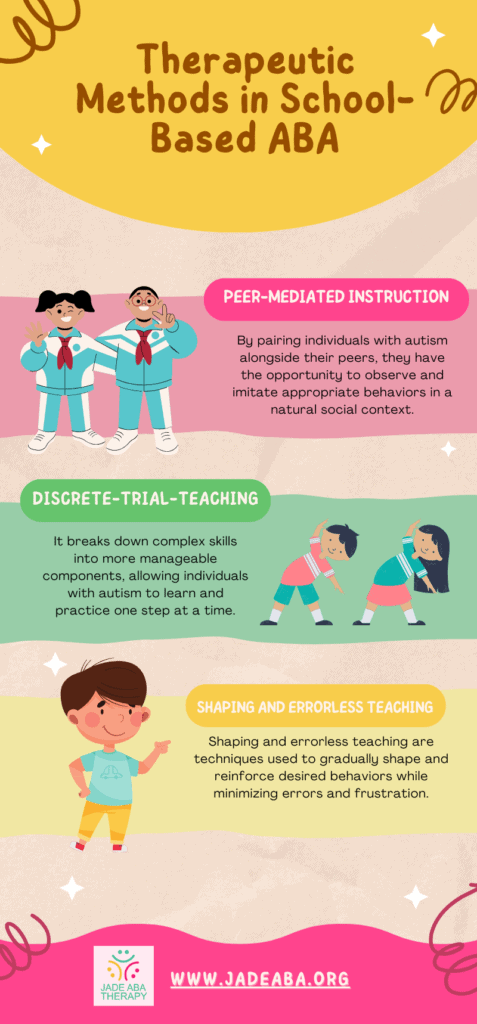In the landscape of special education, Applied Behavior Analysis (ABA) therapy and public schooling stand as two prominent pillars of support for children with developmental differences. While both aim to address the needs of these children, a question often arises: does ABA therapy replace the traditional school setting? This debate sparks discussions among parents, educators, and professionals in the field.

Implementation of ABA in Public Schools
The Individuals with Disabilities Education Act (IDEA) mandates that public schools provide appropriate educational services to students with disabilities, including those with autism. This includes the provision of ABA therapy if there is sufficient evidence that it is necessary to meet the unique needs of the child.
Public schools may employ qualified professionals to conduct ABA therapy within the school environment. This integration allows for a seamless experience for students, as they receive both educational instruction and therapeutic support in one setting. It also alleviates the need for parents and caregivers to choose between one of the two.
Funding for ABA therapy in schools can be obtained through various mechanisms. The three main sources of funding are public school funding, private insurance, and Medicaid. The availability of these funding options may vary depending on the state and specific circumstances.
Public schools are required to provide ABA therapy if it is determined to be necessary to meet the child’s unique needs under IDEA. This funding is typically obtained through the school district’s special education budget. Private schools may also allow outside ABA providers based on the best interest of the student.
Private insurance coverage for ABA therapy in schools can vary depending on the insurance plan and state regulations. Some insurance plans may cover ABA therapy as part of the individual’s behavioral health benefits. It is important to consult with the insurance provider to determine the coverage options available.
Medicaid, a joint federal and state program that provides healthcare coverage for individuals with low income, may also cover ABA therapy in schools. Medicaid coverage varies by state, so it is essential to check the specific guidelines and requirements for ABA therapy coverage.
By integrating ABA therapy within the school system and ensuring adequate funding, students with autism can receive the comprehensive support they need to thrive academically, socially, and behaviorally. It is important, however, to recognize that ABA programming in schools is often considered a “short-term” placement.
Therapeutic Methods in School-Based ABA
When it comes to school-based Applied Behavior Analysis (ABA) therapy, various therapeutic methods are employed to support individuals with autism. These methods are tailored to meet the specific needs of each child and are designed to promote skill development and independence.
Peer-Mediated Instruction
During peer-mediated instruction, trained peers provide prompts, reinforcement, and modeling to support the learning process. This approach promotes social interaction and fosters the development of communication, play, and social skills. By pairing individuals with autism alongside their peers, they have the opportunity to observe and imitate appropriate behaviors in a natural social context.
Discrete-Trial-Teaching (DTT)
Discrete-Trial-Teaching (DTT) is a highly structured teaching method commonly used in ABA therapy, including school-based settings. It breaks down complex skills into more manageable components, allowing individuals with autism to learn and practice one step at a time. This structured approach provides clear expectations and immediate feedback, helping individuals with autism understand and master specific skills.
Shaping and Errorless Teaching
Shaping and errorless teaching are techniques used to gradually shape and reinforce desired behaviors while minimizing errors and frustration. These methods help individuals who may struggle with learning new skills or have difficulty with error correction. By providing continuous positive reinforcement and gradually raising expectations, it allows for the acquisition of new skills through incremental changes.

Support for ABA in School Settings
When it comes to providing support for individuals with autism in school settings, there are key elements that contribute to the success of Applied Behavior Analysis (ABA) therapy. These elements include the role of a Board Certified Behavior Analyst (BCBA) and the development of Individualized Education Plans (IEPs).
Role of Board Certified Behavior Analyst (BCBA)
The knowledge and skills of a Board Certified Behavior Analyst (BCBA) are essential in helping individuals with autism receive ABA therapy in school settings. A BCBA is a qualified individual with the skills and knowledge required to create and carry out successful behavior intervention programs.
The BCBA works closely with teachers, support staff, and parents to assess the needs of the student and develop appropriate strategies for behavior management and skill development. They conduct functional behavior assessments to identify the underlying causes of challenging behaviors and develop behavior intervention plans to address them.
Furthermore, the BCBA provides training and guidance to school staff on the implementation of ABA strategies and techniques. They collaborate with teachers to create a supportive learning environment and ensure consistency across different settings. They also help to maximize the effectiveness of ABA therapy and support the overall educational experience for individuals with autism.
Development of Individualized Education Plans (IEPs)
One part of helping people with autism in school settings is creating Individualized Education Plans or IEPs. These plans specify the precise goals, objectives, and programs that will be offered to meet the needs of each individual and are created collaboratively by a team comprising teachers, parents, and other specialists.
Other areas of support that the student might need, like speech therapy, occupational therapy, or social skills training, are also covered in the IEP. It acts as a thorough plan of study for the student, guaranteeing that their special needs are satisfied and that they have access to the tools and support they need to thrive in the classroom.

Transitioning from ABA to School
When considering the educational journey for individuals with ASD, transitioning from ABA therapy to a school setting is an important milestone. This transition requires careful planning and collaboration between ABA providers and schools to ensure a smooth and successful integration. In this section, we will explore the importance of transition planning and the collaborative efforts between ABA providers and schools.
Importance of Transition Planning
Transition planning plays a vital role in preparing a child with ASD for a school setting. ABA programming should be considered a “short-term” placement, allowing children to learn the necessary skills to be successful in a more traditional school environment. Schools, on the other hand, are required to provide an appropriate education for school-age children (ages 3 and up) in the “least restrictive environment.”
To facilitate a successful transition, discussions about introducing school gradually should occur. This includes developing a plan to reduce ABA therapy hours and gradually transition the child into more socially appropriate environments. By involving all relevant parties, a comprehensive transition plan can be developed to support the child’s successful integration into the school setting.
Collaboration between ABA Providers and Schools
Collaboration between ABA providers and schools is essential for a seamless transition. Early conversations between providers and schools can help establish relationships and facilitate a smoother transition. In certain private schools, ABA therapists may be allowed to attend all or some of the school day with the child. This level of involvement can provide immediate support.
ABA providers, however, may view the transition as a transfer of services, while school personnel may see it as an opportunity to gradually include the child in the school environment. Since the perspective on the transition process may differ between ABA providers and school personnel, all team members must align their expectations around the transition process.
Curriculum and Behavior Support Plans
When considering the choice between ABA therapy and public school for individuals with autism, understanding the differences in curriculum and behavior support plans is essential. These factors play a crucial role in shaping the educational experience and promoting success for students with autism.
Curriculum Differences
The curriculum used in ABA therapy may differ from the curriculum used in schools. In public schools, the curriculum is designed to address a wide range of academic subjects and meet state educational standards. These standards guide the content and learning objectives for each grade level. While accommodations and modifications can be made for students with autism, the overall curriculum framework is typically determined by the school district.
ABA providers, on the other hand, often have their own set of goals for a child, particularly if therapy is being funded through health insurance. However, it is important for family members to collaborate with ABA providers and schools to identify priority goals for their child based on functional and meaningful skills that are appropriate for the school setting. The final goals will then be developed through the individualized education program (IEP) process.
Adapting Behavior Support Plans for School Setting
Behavior support plans that were successful in ABA therapy may not easily translate to a school setting. It is important for the school and the ABA team to discuss what is feasible and realistic in a school environment. Together, they can develop a behavior support plan based on what is known to work with the child, taking into account factors such as the success of the current behavior support plan, the function of the behavior, evidence-based practices, and replacement behaviors that have been taught.
In a school setting, behavior support plans are typically developed through the IEP process. The IEP team, which includes parents, teachers, and other professionals, collaboratively determines the strategies and supports needed to address the student’s behavior challenges. It is important to note, however, that the expectations around the transition process should be discussed among all team members since it will likely impact what is written in the child’s IEP.
The Takeaway
ABA therapy often provides one-on-one support to students with autism. A trained therapist works closely with the child, implementing individualized strategies and interventions to address their specific needs. This personalized attention allows for focused instruction and targeted interventions to help the child develop essential skills. The one-on-one nature of ABA therapy enables the therapist to closely observe the child’s behaviors and provide immediate feedback and reinforcement.
On the other hand, in public school settings, the level of individualized support can vary depending on the resources and programs available. Due to funding levels, funding streams, and the goal of promoting independence, individualized staffing may not always be provided. In some cases, public schools may provide one-on-one aides for students with autism who require more individualized attention.
However, this level of support is typically determined on a case-by-case basis and may not be available to all students. Collaborating with the school and discussing the specific needs of the child is essential to determine the level of support that will be provided. More importantly, regular conversations with both ABA providers and school personnel can facilitate the transition process and ensure that the child receives the necessary support and resources for their educational success.
Sources: